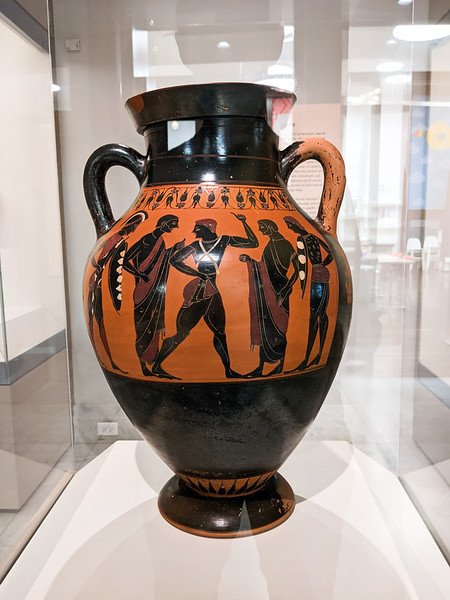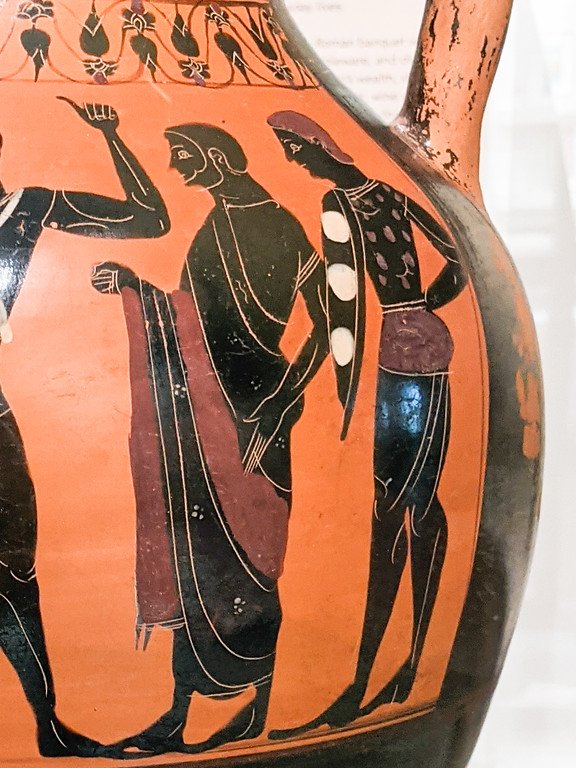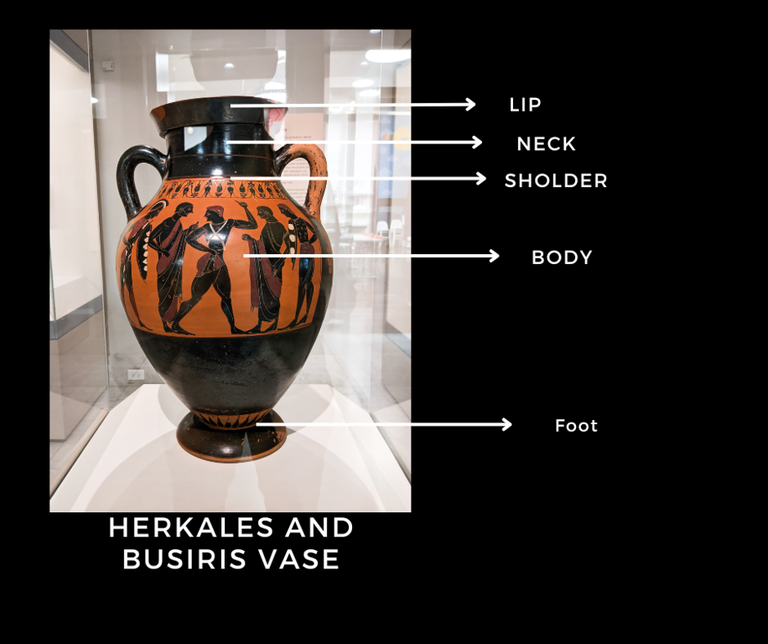I am currently studying for a Classical to Renaissance Art History certificate program at Cambridge University. This class inspired my theme for 2024--- Visual Analysis.
January's visual analysis is of the Greek Vase Herakles and Busiris located in the Cincinnati Art Museum.
Reading a Greek Vase
Joan Mertens from the Metropolitan Museum of Art in New York City opened her book How to Read Greek Vases by stating that "Looking at Greek Vases is a contemplative pursuit, comparable to fishing or gardening." [1]
And the authors of A City of Images compared reading "an an ancient image" to "a kind of mental gymnastics, which is not complicated, but which requires gradual training." [2]
Let's take a look at the vase together.

Attributed to the Swing Painter
Herakles and Busiris, 540 BC
Cincinnati Art Museum, Cincinnati, Ohio
This amphora or container for storing wine is 19 1/8 x 12 3/16 in. (48.5 x 31 cm).
There are five men on this side of the vase. There are two soldiers and two older wise men in himation (traditional clothing) on both sides of a younger man who is leaving, most likely to war. The young man in the center is at the center of the vase. He has a white cross on his chest, his left arm is raised and his legs spread. The story of this young man is juxtaposed with the scene of Herkales on the other side, most likely to inspire courage.
The opposite side of the vase is a scene of Herkales and Busiris, in which Herkales was able to escape from Busiris, the King of Egypt and son of Poseidon.
You can see the whole vase in the video from the Cincinnati Art Museum.
Closer examination
On closer examination, the viewer can see the young man’s hand is raised and his legs spread apart as if walking forward. The young man’s stance is quite exciting because this vase was made in the archaic time (700-401 BC) and the stance of the figures were usually very stiff with their arms to their sides and usually one leg was slightly in front of the other, as we see in the other four figures. ,
The older men, as indicated by their beards, and clothing are closest to the young man, most likely giving him advice. Their clothing, a himitation is a ankle length garment worn over the left shoulder and under the right and is usually wore by women and older men. The artist made the himitations both black and red stripped with little white marks on one of the black bands. The younger men are wearing shorter chitons and all have some type of decoration on the torso of their garment.

Black Figure Technique

This is a great video on the process of Black Figure technique from Kahn Academy.
Anthropomorphism
Another really interesting part of Greek vases is that they are anthropomorphic or have body part names such as the lip, neck, shoulder, body and foot. The scene that we discussed in detail is on the body of the vase. There are also decorations on the shoulder and foot.

Sources:
[1] Metropolitan Museum of Art (New York, N.Y.) and Joan R. Mertens, eds., How to Read Greek Vases (New York : New Haven: Metropolitan Museum of Art ; Distributed by Yale University Press, 2010), 7.
[2] Claude Bérard, ed., A City of Images: Iconography and Society in Ancient Greece (Princeton, N.J: Princeton University Press, 1989), 23.
[3] Ancient Greek vase production

Art Talk Series Highlights
2024
Theme: Visual Analysis
Wow! thanks for the images and the explanation about all the detail! Im in love with ancient cultures and this post refresh my day! I would love to see more of this content, thank you!
@amarettafresca I am so happy that I could share this with you. My next post will also be from Ancient Greece. :)
I read and i enjoyed your post, as much as acold beer in the summer! Really i didn't know about the existance of this vase, and your in depth analysis make something more than happy! Thanks. Greetings ftom Greece!
@giorgakis Wow thanks for the praise. I am so glad you enjoyed the post. I hope to someday visit Greece!
that is a wonderful vases with historical background.
Glad you enjoyed it @lovinggirl
The world of art with so much creativity and beauty to actually behold of. This is awesome 😎
I Agree. Thank you.
There is a lot of thing that I haven’t know thank for sharing dear, Ancient Greek vase is such a great thing to learn.
Glad you enjoyed learning about the Greek Vase.
There is a lot of messages this artwork is passing across and this is awesome of beauty to behold
Agreed, this is a great vase and there is so much to learn. Glad you enjoyed it.
It's a wonderful vases to learn about our history.
It is not easy to make such things, the artist who is there works a lot and then infuses beautiful colors into them and then because of which their beauty increases even more. Its looks so pretty.
Creativity at its finest
♥️💯